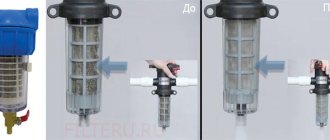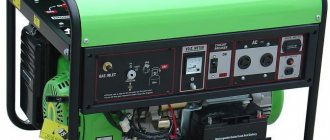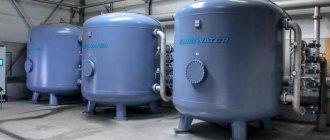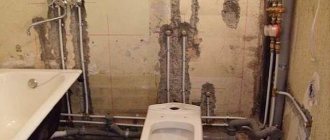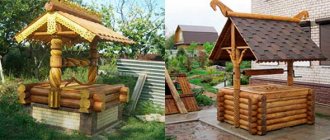There was an urgent need in the apartment to purchase a mainline device. What should the consumer do? What parameters should I focus on? Are there such manufacturers in Russia that there is no shame in their products and even they are to some extent ahead of foreign competitors? After all, domestically produced goods will definitely cost less. And if it is also of some new technical nature, then this is a double benefit. How to determine the rating of the best main filters ?
What is the difference between installing a filtration system for hot water supply and hot water supply?
In fact, installing a main filter for hot water is no different from installing a filter for cold water.
The technique is the same, but it is important to consider that filters designed for hot water can also be used for cold water, but vice versa - not .
In addition, when installing filtering equipment on a hot water main, you need to be especially careful, since if there is a leaky connection somewhere, it will not be as easy to fix as with a cold water main.
Criterias of choice
The choice will depend on the quality of hot water flowing through the pipes and what requirements the apartment owners will have for it. If the water is hard, it is better to purchase a filter with an additional softening function.
The second criterion is power or throughput. To do this, you need to multiply the number of residents by the standard value of hot water consumption. This parameter is equal to 5-8 liters per day.
The third criterion is the availability of a quality certificate. Many buyers neglect this document. However, its presence is a guarantee of quality that confirms the authenticity of the product. It’s good if the package includes a warranty card.
Pre-installation preparation
Before starting work, you should carefully think through everything and choose a place for installation. Small-sized filters can be installed anywhere, but for large filters it is better to take care of a small special room and make a kind of storage room.
Small filter flasks can also be installed under the sink, or directly at the inlet of the main line, which is a more correct option.
The filters themselves also need to be prepared and checked. We assemble the flasks, check the presence of filter elements (cartridges), and try them on for the planned installation location. We measure the dimensions so that we know what cuts will need to be made on the pipes.
Case types
There are 2 types of cases: BB (Big Blue) and SL (Slim Line). The first type is large. Its body is usually blue. The height of such a filter is 10 inches (about 25 cm), and the diameter is 18.5 cm. This type of device is used to capture particles of chlorine, iron, and organic substances. They are also equipped with water softeners.
Slim Line has more compact dimensions. The diameter of such filters is 13–14 cm. And their height is smaller. Such devices can be used in cases where space does not allow the use of a larger filter. They use color gradation: if the filter housing is transparent or blue, then this device is intended for cold water. The hot flask will be colored red, orange or brown.
How to install it yourself?
When installing a complex filtration system, it is better for a beginner to start with a cold line, since working with a hot line is unforgiving of mistakes.
For cold water
The first step is to prepare the tools that you may need:
- FUM tape;
- perforator;
- plastic dowels;
- screwdriver;
- soldering iron for pipes;
- pipe pruner;
- couplings.
A soldering iron and couplings are needed when the pipes are made of plastic. If the line is metal, then you will need a grinder and a welding machine, threaded pipes.
Let's look at the installation diagram:
Filters must be installed strictly in order - first of all, mud filters (coarse filters) are installed, then mechanical cleaning filters, then, if desired, other cartridge filters (softening, iron-removing, etc.).
Process
When you have decided on the installation location and prepared the tools, you can begin installation:
- Shut off the water to the apartment. Open any tap to release the remaining water from the system.
- Mark with a pencil the location of the filter, as well as the mounting holes.
- Two or three holes are made in the wall with a perforator, depending on the size of the filter.
- Plastic dowels are inserted into the holes.
- The pipe is being cut. It is better to immediately place some kind of vessel under the cut site, since there could be water left in the system.
Connecting couplings are attached to the filter. The entire connection is sealed either with sealant or FUM tape.- The filter is attached to the wall with self-tapping screws. This is necessary to avoid vibration, which can damage the water supply elements.
- Shut-off valves are installed on the pipe.
- The mud trap is installed.
- American type couplings are put on the mud pan or pipe. It all depends on the material from which the pipe is made. Either the coupling is simply put on, or soldered, or welded.
- The threads on the coupling are wrapped with FUM tape or lubricated with sealant.
- The pipe is connected to the filter. All connections must be tightened tightly with a wrench. The filter must be installed correctly! It has an input – “IN” and an output “OUT”. The main thing is not to confuse.
- The water supply is restored.
- Open any tap so that the filter flask is filled with water and the cartridge is completely saturated. It is better to temporarily place a dry cloth under the installed filter in case of a leak.
That's it, the installation of the single-stage filter is complete. Other filters are installed using the same system, with the exception of the reverse osmosis filter. And mud collectors and multi-stage cartridge filters are installed in exactly the same way.
For hot water
We also prepare the tool:
- FUM tape;
- perforator;
- plastic dowels;
- screwdriver;
- soldering iron for pipes;
- pipe pruner;
- couplings.
Next you need to familiarize yourself with the connection diagram:
As you can see, the scheme is not much different from the equipment of a filtration system for cold water. For hot water, it is recommended to use a mud trap without fail.
Procedure
Let's start the installation process:
- Turn off the water in the apartment. Open any hot tap to release any remaining water from the system.
- Mark with a pencil the location of the filter, as well as the mounting holes.
- A puncher makes two or three holes in the wall, depending on the size of the filter.
- Plastic dowels are inserted into the holes.
- The pipe is being cut. It is better to immediately place some kind of vessel under the cut site, since there could be water left in the system. Carefully! The water is hot - you can get burned!
Connecting couplings are attached to the filter. The entire connection is sealed either with sealant or FUM tape.- The filter is attached to the wall with self-tapping screws. Important! Make sure the filter is suitable for hot water!
- Shut-off valves are installed on the pipe.
- The mud trap is installed.
- American type couplings are put on the mud pan or pipe.
- The threads on the coupling are wrapped with FUM tape or lubricated with sealant. The sealant must be heat-resistant.
- The pipe is connected to the filter. All connections must be tightened tightly with a wrench.
- If a multi-stage filter is installed, then each glass is attached in turn to each other using the same method. The filter must be installed correctly! It has an input – “IN” and an output “OUT”. The main thing is not to confuse.
- The water supply is restored.
- Open any tap so that the filter flask is filled with water and the cartridge is completely saturated.
Comparison table of characteristics
To compare the devices considered, we summarize some of their characteristics in a table.
| Name | Max. temperature, degrees | Number of cleaning stages | Max. pressure, bar | capacity , l/min. | Porosity, µm | Weight, kg |
| Geyser Typhoon 10 SL 1/2 | 95 | 1 | 7 | 15 | 10 | 3,5 |
| Aquaphor Viking Mini | 40 | 1 | 6,3 | 10 | 5 | 4 |
| TITANOF KM 1 047 | 40 | 2 | 10 | 16,6 | 5 | 2,55 |
| Aurus 2 | 95 | 4 | 16 | 30 | 1 | — |
| Barrier BM 1/2 | 40 | 1 | 7 | 10 | 1 | 1,15 |
| Fibos carbon filter for cold water 3000 l/h | 40 | 1 | — | 50 | — | — |
| Poseidon – 1 RG thread 1/2” | 95 | 1 | 8 | — | 5 | 1,5 |
Recommendations
For both cold and hot mains, it is best to make a “bypass path” . This is necessary so that if the filter becomes too dirty and a leak appears, you can let water in directly, bypassing the filter. It looks like this:
In practice, it looks like this:
It is necessary to install such a bypass before all filter elements, before the mud trap, but after the meter.
Cartridge type
The type of contaminants that a water filter will capture depends on the type of cartridge that is used. Letter markings will help you navigate:
- BA - the cartridge actively captures iron.
- BS – softens water.
- Activated carbon – collects chlorine.
- Polyphosphates prevent scale formation on household appliances.
Service
Maintenance of the main filter consists of washing the mud trap and regularly replacing the cartridge . To replace the filter element (cartridge) in the filter bowl, you must:
- Turn off the water.
- Drain the water in the system by opening any tap.
- Place some container, such as a saucepan, under the glass.
- Using the special key that comes with the filter, unscrew the glass.
- Install a new one in place of the old cartridge.
- Reconnect the glass with the filter.
- Tighten tightly with a wrench.
- Connect the water and let the system run for about 5 minutes.
Filter maintenance is the same for both hot and cold water. The only caveat: when turning off the hot water supply, you need to let the cartridge cool down.
Everything you would like to know about in-line water filters can be found in this section of the site.
The most popular for a private home
Equipment of varying degrees of complexity is built into separate water supply systems. These can be simple mesh devices or multi-component water filtration systems.
Fibos-3 with pressure gauge
Ultra-fine filter. It will remove not only large contaminants from the water, but also bacteria.
Characteristics:
- 1 degree of purification;
- 50 l/min productivity;
- mounted with a ¾ inch connection;
- bactericidal additive;
- pressure gauge included.
Advantages:
- excellent degree of cleaning;
- reliability and efficiency;
- works without replaceable cartridges.
Flaws:
- quite high cost;
- frequent problems with the thread inside;
- After a while, work efficiency decreases.
Approximate price 15,000 rubles. Read reviews here.
Many users believe that Fibos-3 is a reliable device that does an excellent job of cleaning. At the same time, there is no effect on the pressure in the water supply. Other consumers say that the thread inside the filter often breaks under the pressure of water.
Aurus 6
Fine cleaning equipment. Aurus 6 was created specifically to provide high-quality water to private homes, kindergartens, cafes, and other institutions.
Characteristics of Aurus 6:
- Cleans up to 100 l/min.
- The degree of purification is 1 micron.
- Processes cold (from + 4°C) and hot (up to 95°C) water.
- The pressure in the water supply network can vary from 0.5 to 16 bar.
- Height - 500 mm, width - 150 mm.
The Aurus 6 filter has an unlimited service life. Its design does not have replaceable cartridges. Aurus 6 purifies cool and hot water.
Advantages of the equipment:
- combined mechanical cleaning and bactericidal treatment with silver ions;
- filters water at temperatures up to 95°C;
- lack of replaceable cartridges and filling materials;
- The body is made of anti-corrosion metal.
Disadvantage: periodic drainage of deposited contaminants is required. The price of Aurus 6 is moderate: about 20,000 rubles.
All reviews note the ease of installation of Aurus 6 and the lack of consumables.
Fibos 5
Fibos 5 is the senior model in the Fibos line of mainline filters.
Equipment characteristics:
- Purifies 83 liters of water in 1 minute.
- The degree of filtration is 1 micron.
- Works when the pressure in the water supply varies from 0.5 to 16 bar.
- Purifies cold (from +4°C) and hot (up to 95°C) water.
- Case height - 308 mm, width - 138 mm.
A significant advantage is that the high performance of the Fibos 5 main filter allows it to be used not only in dachas and cottages, but also for swimming pools.
Advantages of Fibos 5:
- no replaceable cartridges;
- protects against harmful impurities and bacteria;
- easy to install.
Disadvantage: you have to manually drain the contaminants accumulated during filtration. You can buy Fibos 5 for (approximately) 24,000 rubles.
Reviews indicate that users are especially pleased with the bactericidal capabilities of the Fibos filter.
R.B.M.
The equipment performs preliminary purification of well or well water.
Device characteristics:
- Removes suspended matter with a dispersion of 100 microns or more.
- Operating temperature - up to 100°C.
- The pressure in the water supply is from 1 to 16 bar.
- An additional device is a pressure gauge.
- Country of origin: Italy.
The RBM filter performs the functions of preliminary water purification. European quality. This feature, combined with simplicity, is the reason why the RBM filter is included in the list of top models.
Advantages of the RBM filter:
- no cartridges;
- easy to install and maintain;
- allows you to determine the pressure in the system.
Feature: 100 microns is not the highest degree of purification, but for a pre-filter it is normal.
Flaws:
- Contaminants generated during self-washing are drained manually;
- There is no bacterial water purification.
The price of RBM equipment is about 2,500 rubles.
Users characterize the RBM filter as a reliable, inexpensive, and easy-to-maintain device . It is noted that RBM is able to withstand frosty winters (freezing), while other filters fail. Read reviews here and here.
Process nuances
When purchasing a system, you must carefully study the manufacturer’s instructions, which provide the consumer with a step-by-step algorithm of actions. The technological features of the various models are similar, so installing the device will not cause any particular difficulties.
Please note the following:
- Before purchasing a kit, it is advisable to take a sample of the liquid and take it to the laboratory. With the results of the analysis, go to the store, where the managers will select the appropriate option for you with the required filler. You should not take a model that visually appeals to you, as it may not be suitable for your purpose, may not give a positive effect, and will quickly fail due to an incorrectly selected adsorbent.
- Among Russian citizens, two/six-stage units mounted under the kitchen sink in a horizontal or vertical position have become widespread. The only negative is the provision of a large space for replacing toners, which have to be renewed at a certain interval. This means that you will have to take care of free access for maintenance and repair. The entire structure must be positioned so that it is not subject to compression or squeezing, and the plumbing fixtures are in a visible place.
- Be prepared for financial costs, as all system components are not cheap.
Advantages and disadvantages of main filters
Any devices have their advantages and disadvantages. And filters are no exception. So, what can you give them pluses for:
- Cleaning all water entering the apartment.
- Possibility of performing all cleaning steps in one device.
- Elimination of unpleasant odors and tastes.
- Protecting household appliances from scale.
- The water after the filter becomes clean, transparent, and turbidity is removed.
- Cleaning from rust.
- Preventing the formation of rust, limescale, and drips on plumbing fixtures and household appliances.
The following features can be noted as disadvantages:
- Regular washing of the mesh cartridges is necessary.
- Fine cleaning cartridges also need to be changed periodically, which leads to additional costs. The dirtier the inlet water, the more often you will have to spend money on it.
- The flask also needs periodic washing, as sediment accumulates on it.
- Large size, cumbersome, because the standard layout of apartments does not always allow for the installation of a cleaning device conveniently and without problems.
